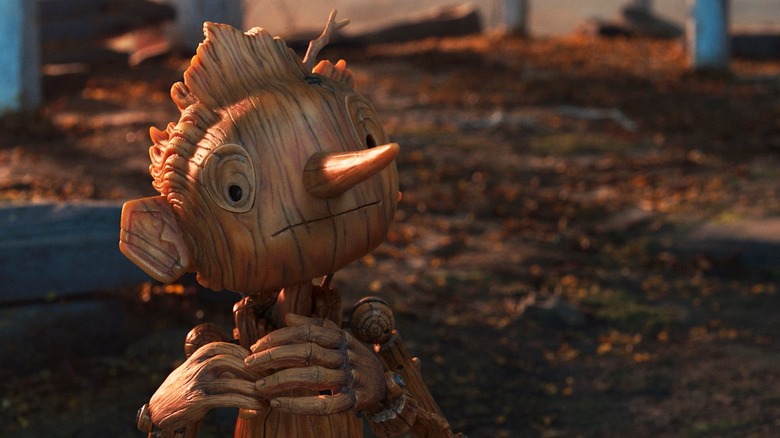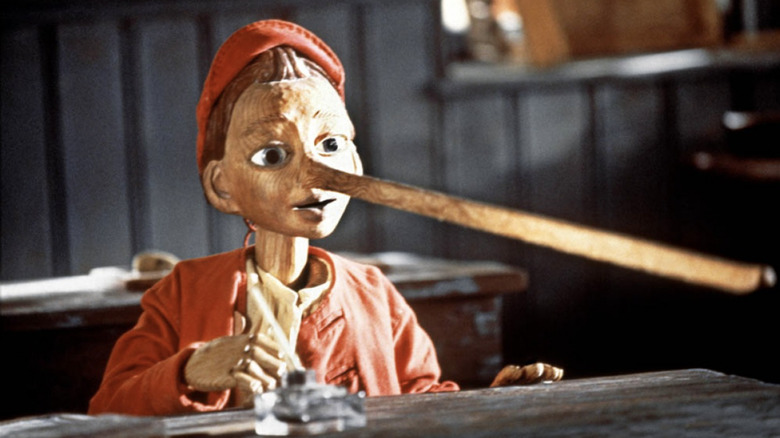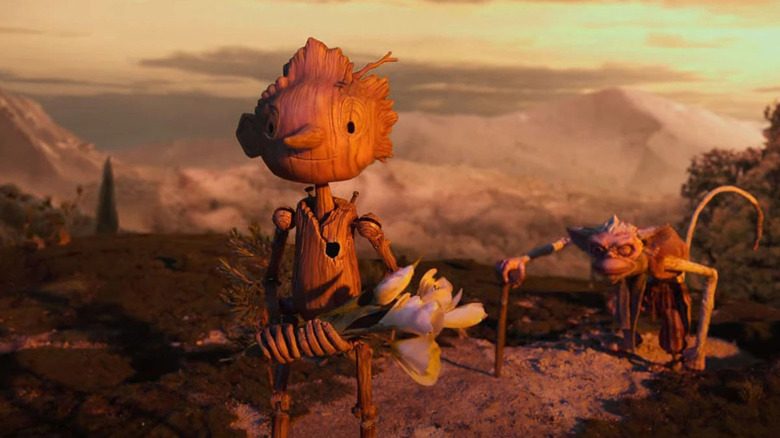Guillermo Del Toro Reveals Why He Made One Key Change To The Story Of Pinocchio
This article contains spoilers for Guillermo del Toro's "Pinocchio."
Guillermo del Toro made something truly magical with his adaptation of the classic children's tale, "Pinocchio." The stop-motion film is a loving interpretation of Carlo Collodi's original novel from 1883, based largely on the original source material rather than the Disney animated feature from 1940 that has dominated the public's consciousness of what a "Pinocchio" story looks like. Del Toro spent over a decade trying to bring his vision to life, with the streaming juggernaut Netflix helping push the film across the finish line, with the final product becoming the best Netflix original release of 2022. "Pinocchio" is a stunning, inventive, and heartwarming story about a wooden puppet who magically comes to life, but del Toro made one major, and welcome change to the beloved tale.
In a recent piece from Deadline, del Toro talked about how the script came to be, which was co-written with Emmy Award-winner, Patrick McHale ("Adventure Time," "Over the Garden Wall"). While the character of Pinocchio is synonymous (mostly due to Disney's version) with the idea of "becoming a real boy," del Toro did not want his wooden boy to become human, or even desire to become one. "When I was a kid, I said, 'So what it means to be loved, is that you have to change?' I couldn't accept that, so the writers took the classic material and retold a few strands of the original to change the key of how the material could sing," said del Toro. It's a welcome change that brings an important message to young viewers, that they are wonderful and worthy of love exactly as they are.
Pinocchio throughout the years
While the Walt Disney Company is responsible for arguably the most well-known retelling of Carlo Collodi's novel, a variety of other creatives have tried their hand at the tale of a wooden boy with a nose that grows from dishonesty. In fact, Disney wasn't even the first studio to try and bring the puppet boy to life. Italy has been producing Pinocchio stories since the advent of the moving picture, with Giulio Antamoro responsible for the first cinematic adaptation in a live-action silent film of the same name released in 1911. Raoul Verdini and Umberto Spano historically would have been the first to showcase the character in the animated feature "Le Avventure di Pinocchio," but the film was never completed and is now considered lost. Interestingly, had the film come to fruition, it would have become the first cel-animated feature film in history, arriving a year sooner than "Snow White and the Seven Dwarfs."
Pinocchio has made appearances in countless made-for-TV specials and feature presentations from across the globe and has had his fair share of ... questionable interpretations. 1996 saw the horror film "Pinocchio's Revenge," where Verne Troyer and Dick Beals played the titular character as a killer puppet. Teen heartthrob Jonathan Taylor Thomas would play the character in "The New Adventures of Pinocchio" just a few years later, which shares the Disney ending of turning the wooden boy into a real, human child. Despite the numerous versions of the Pinocchio story brought to the screen, Guillermo del Toro's film feels revolutionary for the bold decision to keep Pinocchio as a puppet at the end.
A film that doesn't talk down to children
Guillermo del Toro's decision to bring in Patrick McHale to work on the script was brilliant because shows like "Adventure Time" and "Over the Garden Wall" share a similar DNA to his version of "Pinocchio." All three stories are filled with plenty of fantastical whimsy but also aren't afraid to introduce difficult themes to younger viewers. "I knew I needed somebody who writes for animation because you write very differently for animation, the way you write dialogue is entirely different," del Toro told Deadline. It was this matter of thinking that also inspired the decision to set "Pinocchio" during the fascist dictatorship of Benito Mussolini.
According to del Toro, this decision was done as a means "to show a world in which everybody behaves like a puppet and obeys, and the actual puppet is the only one who is disobedient and refuses to change." This was a truly inspired decision, as the cursed "Pleasure Island" scene made famous in Disney's version is replaced by a fascist military youth training camp. The sentiment is the same — sending Pinocchio to a locale designed to irreparably change young boys — but based on a horrific reality, even for a film about a sentient wooden child. These adventurous changes ultimately helped elevate the classic story to the next level and solidified Guillermo del Toro's "Pinocchio" as a must-watch for all ages.
Bring the Kleenex, you're gonna need it.


